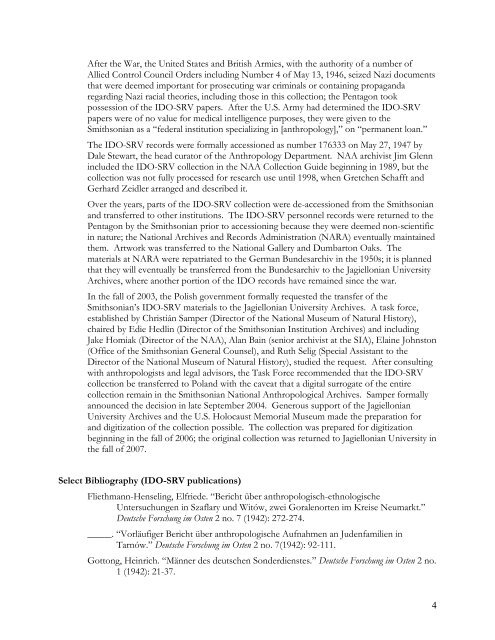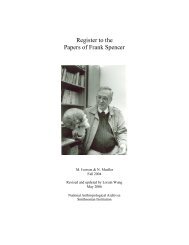Records of the Institut für Deutsche Ostarbeit, Sektion für Rasse- und ...
Records of the Institut für Deutsche Ostarbeit, Sektion für Rasse- und ...
Records of the Institut für Deutsche Ostarbeit, Sektion für Rasse- und ...
Create successful ePaper yourself
Turn your PDF publications into a flip-book with our unique Google optimized e-Paper software.
After <strong>the</strong> War, <strong>the</strong> United States and British Armies, with <strong>the</strong> authority <strong>of</strong> a number <strong>of</strong><br />
Allied Control Council Orders including Number 4 <strong>of</strong> May 13, 1946, seized Nazi documents<br />
that were deemed important for prosecuting war criminals or containing propaganda<br />
regarding Nazi racial <strong>the</strong>ories, including those in this collection; <strong>the</strong> Pentagon took<br />
possession <strong>of</strong> <strong>the</strong> IDO-SRV papers. After <strong>the</strong> U.S. Army had determined <strong>the</strong> IDO-SRV<br />
papers were <strong>of</strong> no value for medical intelligence purposes, <strong>the</strong>y were given to <strong>the</strong><br />
Smithsonian as a “federal institution specializing in [anthropology],” on “permanent loan.”<br />
The IDO-SRV records were formally accessioned as number 176333 on May 27, 1947 by<br />
Dale Stewart, <strong>the</strong> head curator <strong>of</strong> <strong>the</strong> Anthropology Department. NAA archivist Jim Glenn<br />
included <strong>the</strong> IDO-SRV collection in <strong>the</strong> NAA Collection Guide beginning in 1989, but <strong>the</strong><br />
collection was not fully processed for research use until 1998, when Gretchen Schafft and<br />
Gerhard Zeidler arranged and described it.<br />
Over <strong>the</strong> years, parts <strong>of</strong> <strong>the</strong> IDO-SRV collection were de-accessioned from <strong>the</strong> Smithsonian<br />
and transferred to o<strong>the</strong>r institutions. The IDO-SRV personnel records were returned to <strong>the</strong><br />
Pentagon by <strong>the</strong> Smithsonian prior to accessioning because <strong>the</strong>y were deemed non-scientific<br />
in nature; <strong>the</strong> National Archives and <strong>Records</strong> Administration (NARA) eventually maintained<br />
<strong>the</strong>m. Artwork was transferred to <strong>the</strong> National Gallery and Dumbarton Oaks. The<br />
materials at NARA were repatriated to <strong>the</strong> German B<strong>und</strong>esarchiv in <strong>the</strong> 1950s; it is planned<br />
that <strong>the</strong>y will eventually be transferred from <strong>the</strong> B<strong>und</strong>esarchiv to <strong>the</strong> Jagiellonian University<br />
Archives, where ano<strong>the</strong>r portion <strong>of</strong> <strong>the</strong> IDO records have remained since <strong>the</strong> war.<br />
In <strong>the</strong> fall <strong>of</strong> 2003, <strong>the</strong> Polish government formally requested <strong>the</strong> transfer <strong>of</strong> <strong>the</strong><br />
Smithsonian’s IDO-SRV materials to <strong>the</strong> Jagiellonian University Archives. A task force,<br />
established by Christián Samper (Director <strong>of</strong> <strong>the</strong> National Museum <strong>of</strong> Natural History),<br />
chaired by Edie Hedlin (Director <strong>of</strong> <strong>the</strong> Smithsonian <strong>Institut</strong>ion Archives) and including<br />
Jake Homiak (Director <strong>of</strong> <strong>the</strong> NAA), Alan Bain (senior archivist at <strong>the</strong> SIA), Elaine Johnston<br />
(Office <strong>of</strong> <strong>the</strong> Smithsonian General Counsel), and Ruth Selig (Special Assistant to <strong>the</strong><br />
Director <strong>of</strong> <strong>the</strong> National Museum <strong>of</strong> Natural History), studied <strong>the</strong> request. After consulting<br />
with anthropologists and legal advisors, <strong>the</strong> Task Force recommended that <strong>the</strong> IDO-SRV<br />
collection be transferred to Poland with <strong>the</strong> caveat that a digital surrogate <strong>of</strong> <strong>the</strong> entire<br />
collection remain in <strong>the</strong> Smithsonian National Anthropological Archives. Samper formally<br />
announced <strong>the</strong> decision in late September 2004. Generous support <strong>of</strong> <strong>the</strong> Jagiellonian<br />
University Archives and <strong>the</strong> U.S. Holocaust Memorial Museum made <strong>the</strong> preparation for<br />
and digitization <strong>of</strong> <strong>the</strong> collection possible. The collection was prepared for digitization<br />
beginning in <strong>the</strong> fall <strong>of</strong> 2006; <strong>the</strong> original collection was returned to Jagiellonian University in<br />
<strong>the</strong> fall <strong>of</strong> 2007.<br />
Select Bibliography (IDO-SRV publications)<br />
Fliethmann-Henseling, Elfriede. “Bericht über anthropologisch-ethnologische<br />
Untersuchungen in Szaflary <strong>und</strong> Witów, zwei Goralenorten im Kreise Neumarkt.”<br />
<strong>Deutsche</strong> Forschung im Osten 2 no. 7 (1942): 272-274.<br />
_____. “Vorläufiger Bericht über anthropologische Aufnahmen an Judenfamilien in<br />
Tarnów.” <strong>Deutsche</strong> Forschung im Osten 2 no. 7(1942): 92-111.<br />
Gottong, Heinrich. “Männer des deutschen Sonderdienstes.” <strong>Deutsche</strong> Forschung im Osten 2 no.<br />
1 (1942): 21-37.<br />
4








